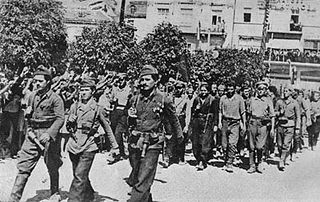 W
WThe People's Republic of Bulgaria was the official name of Bulgaria, when it was a socialist republic that existed from 1946 to 1990 ruled by the Bulgarian Communist Party (BCP), which in turn ruled together with its coalition partner, the Bulgarian Agrarian People's Union. Bulgaria was part of Comecon and a member of the Warsaw Pact and was closely allied with the Soviet Union during the Cold War. The Bulgarian resistance movement during World War II deposed the Kingdom of Bulgaria administration in the Bulgarian coup d'état of 1944 which ended the country's alliance with the Axis powers and led to the People's Republic in 1946.
 W
WBalkanton was a state-owned record manufacturing company in Bulgaria founded in 1952. Many of the produced records were, or still are available in the countries of the former Soviet Bloc. Balkanton's plant in Sofia was equipped for all aspects of record manufacturing from recording the masters and pressing the vinyl records to printing the cover. Multi-channel sound recording was introduced in 1972 with equipment purchased from England. In 1982 Balkanton received its own digital recording equipment. By the mid-1980s annual LP production reached 9 million units. The company mainly produced LPs and from 1980 it started to manufacture cassettes. Being the only record company in Bulgaria during four decades, Balkanton accumulated a vast library of performances of folk, classical, Bulgarian and foreign popular music, theater, poetry and more. After a couple of attempts to reorganize the company in the 1990s, it was finally privatized in 1999. Currently, Balkanton is reissuing some of its old recordings, mainly in the digital format, closing deals with digital distributors like Amazon.com, Spotify, Napster, 7digital and more.
 W
WThe Belene labour camp, also referred to as Belene concentration camp, was part of the network of forced labour camps in Communist Bulgaria. It was located on the Belene Island, between two branches of the Danube river. At the height of Valko Chervenkov's repressions in 1952, the camp had 2,323 inmates - 2,248 men and 75 women.
 W
WThe 1944 Bulgarian coup d'état, also known as the 9 September coup d'état, was the forcible change of the government of Kingdom of Bulgaria carried out on the eve of 9 September 1944. In Communist Bulgaria it was called People's Uprising of 9 September – on the grounds of the broad unrest, and Socialist Revolution – as it was a turning point politically and the beginning of radical reforms towards socialism.
 W
WThe Bulgarian People's Army was the military of the People's Republic of Bulgaria (1944-1990).
 W
WThe Council for Mutual Economic Assistance was an economic organization from 1949 to 1991 under the leadership of the Soviet Union that comprised the countries of the Eastern Bloc along with a number of socialist states elsewhere in the world.
 W
WThe Committee for State Security, popularly known as State Security was the name of the Bulgarian secret service under the People's Republic of Bulgaria and the Cold War, until 1989.
 W
WThe Defence Assistance Organisation, initially the Voluntary Defence Assistance Organisation was a government-sponsored network of youth clubs in the People's Republic of Bulgaria.
 W
WThe Georgi Dimitrov Mausoleum was a ceremonial tomb on Prince Alexander of Battenberg Square in Sofia, Bulgaria. It was built in 1949 to house the embalmed body of Georgi Dimitrov, the first leader of Communist Bulgaria. After his death in 1950, the second communist leader of Bulgaria, Vasil Kolarov, was buried in the second niche of the east wall of the mausoleum. In 1999, following a heated public debate, it was destroyed by Ivan Kostov's UDF government.
 W
WThe Museum of Socialist Art in Sofia is a museum of art which covers the history of the communist era in Bulgaria. It was established on 19 September 2011 amidst a controversy over the name, which was initially proposed as "Museum of Totalitarian Art". The museum's collection of large and small statues, busts, and paintings represents the period from 1944 to 1989, from the establishment of the People's Republic of Bulgaria to the fall of communism. The museum spread over an area of 7,500 square metres (81,000 sq ft) in the Sofia suburb known as "Red Star is in three parts - a park with sculpture installations drawn from the communist period, an exhibition hall with paintings and easel representations, and a media or video hall in which films and newsreels related to the communist period are screened.